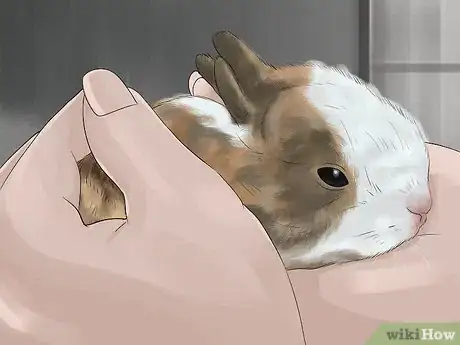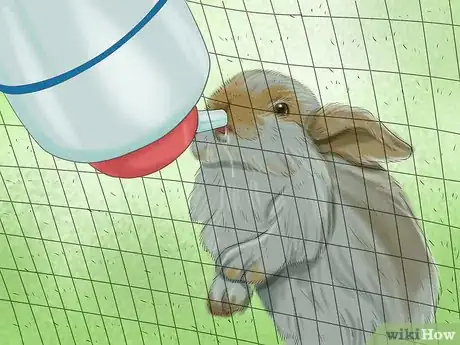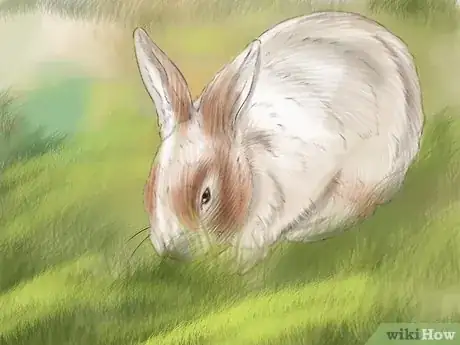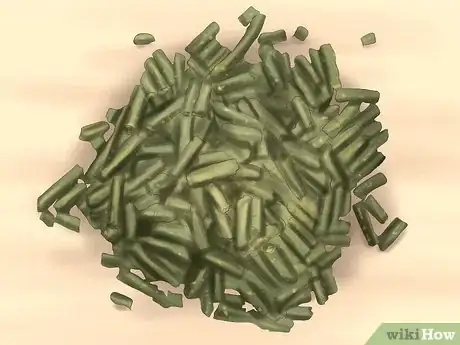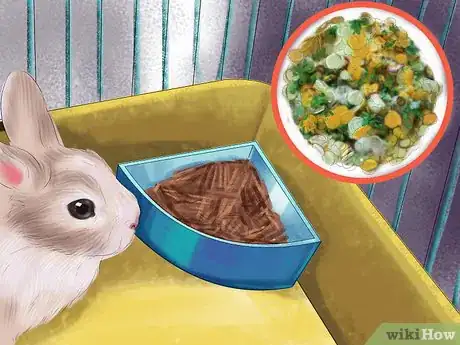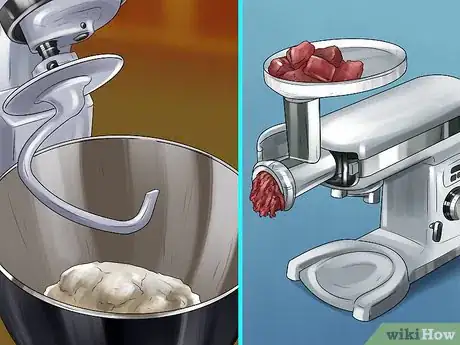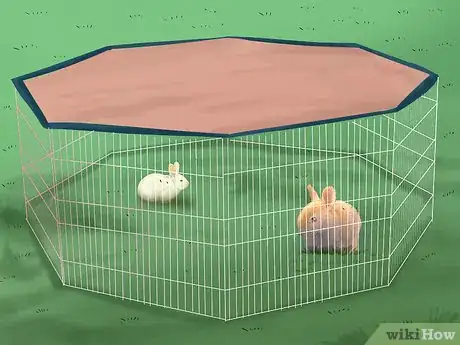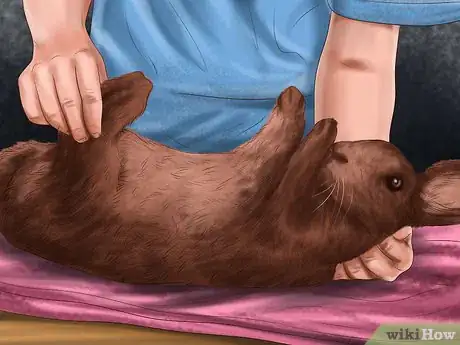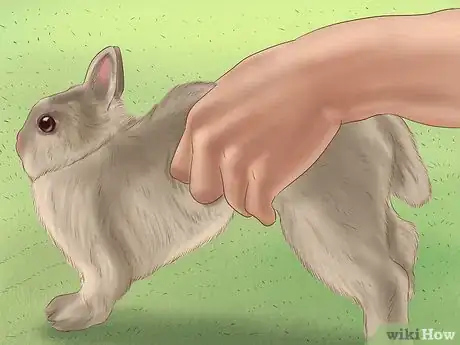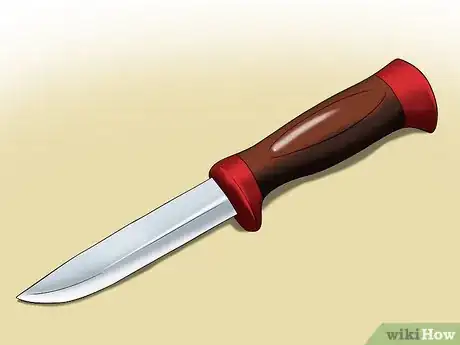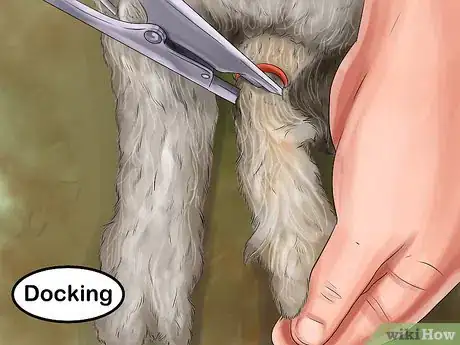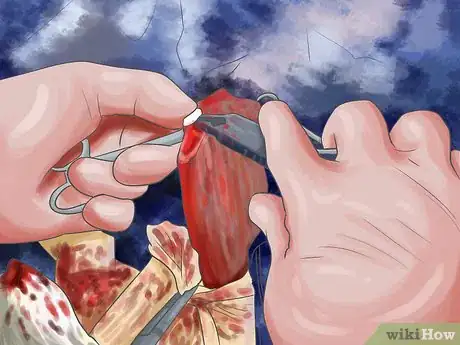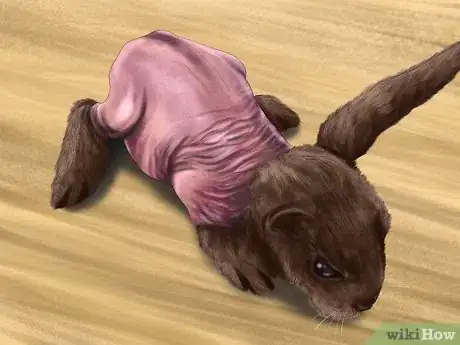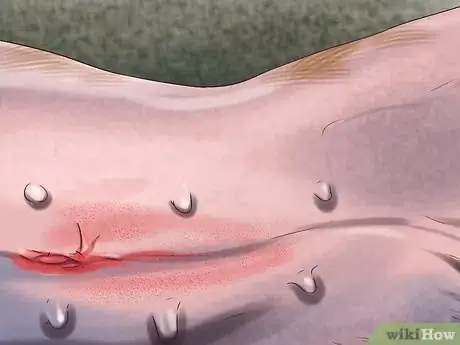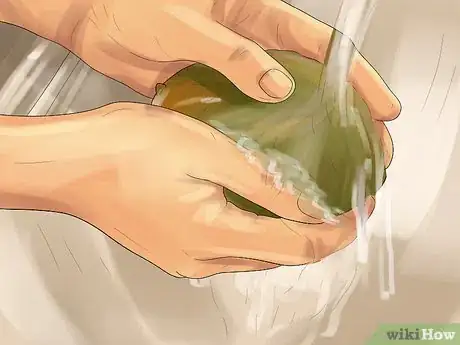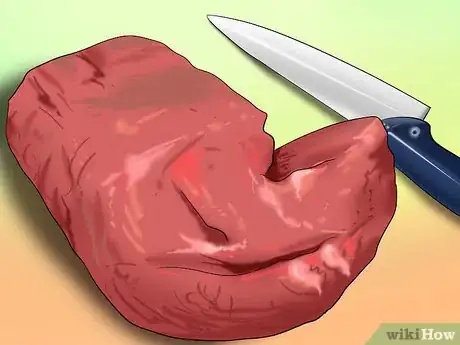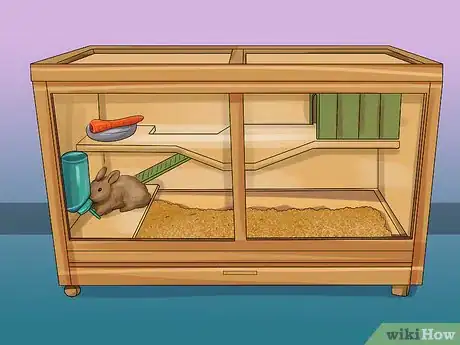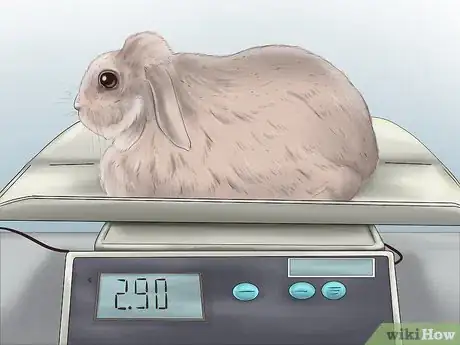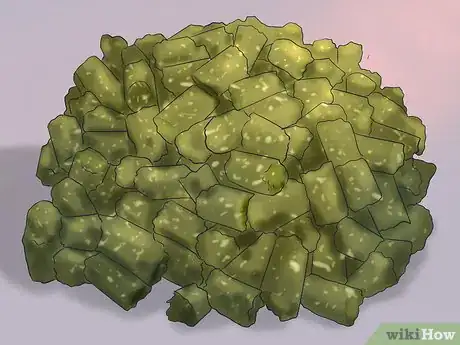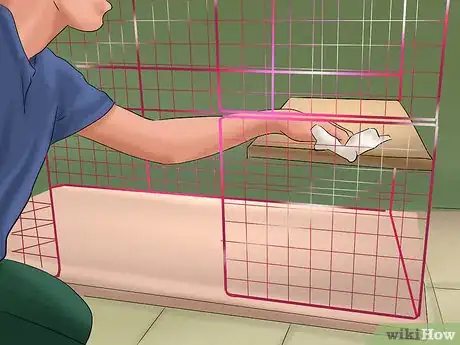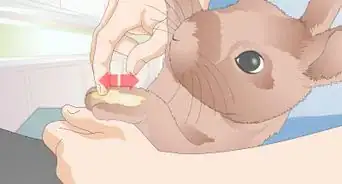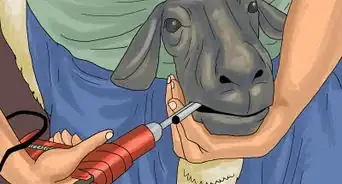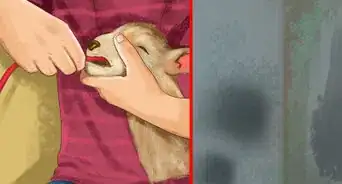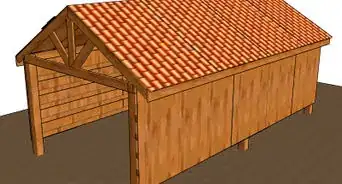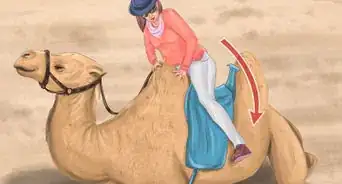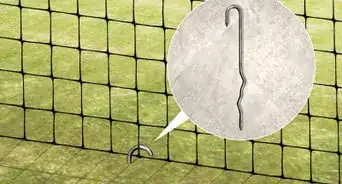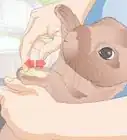X
wikiHow is a “wiki,” similar to Wikipedia, which means that many of our articles are co-written by multiple authors. To create this article, 40 people, some anonymous, worked to edit and improve it over time.
There are 10 references cited in this article, which can be found at the bottom of the page.
This article has been viewed 282,961 times.
Learn more...
Domestic rabbits are highly valued for their low fat, low cholesterol, and high quality proteins. They are entirely white meat. Rabbit compares very favorably to chicken, turkey, and some fish for its beneficial health virtues and its adaptability.
Steps
Method 1
Method 1 of 3:
Raising Rabbits
-
1Rabbit breeding stock can be obtained from many different sources. One good way is to go to a fair where there are rabbits and contact the owners which are usually listed on the show cases.[1]
- 3 to 4 litters of 5 to 10 young can be thrown by a healthy, mature female (doe) each year.
- One male (buck) can service up to twenty to thirty does, but in order to keep the gene pool healthy, you should have one buck for each 5 does. Make sure you keep records of which does are bred by which bucks, and keep rotating the animals to keep the gene pool as large as possible.
- The best meat breeds are California and New Zealand or a combination of the two. Most consider the Flemish Giant unsuitable for a meat rabbit, due to the meat to bone ratio, also the amount of food consumed to meat ratio. It is okay to cross with a New Zealand for meat production.
-
2Get the right pen. The pen should be a minimum of 5 feet (1.5 m) by 6 feet (1.8 m) for this large breed, but slightly smaller for the smaller breeds. Rabbits need space! The floor should be made of a sturdy wire mesh with about 3⁄4 inch (1.9 cm) square holes to accommodate droppings and urine. Do give the rabbit someplace else to stand, however. Standing on wire full time can hurt a rabbit's feet. A full tray or box the full size of the floor of the pen with all four sides about 2 1⁄2 inches (6.4 cm) high should be slid under the pen to catch the animal waste. This tray should be emptied once per week and rinsed with a disinfectant.[2] Be careful when using bleach, as it will react with the urine and give off a harmful gas!
- A solid compartment about 1 1⁄2 feet (0.5 m) long and 1 1⁄2 feet (0.5 m) wide should be included in the pen to give the doe privacy while she is having her young. this will keep mortality of the young down to a great extent. Be sure there is plenty of dried hay in the pen when she is "due".
Advertisement -
3Know that female rabbits will conceive at any time they have an "encounter" with a buck. There is no set estrous period.
- The young should be separated from the mother at about 6 weeks.
- The doe is ready for breeding immediately after separation from her young.
- The rabbit pregnancy period is 28-30 days, with the doe able to mate within hours of giving birth. However, it's advised to wait a month so as not to overtire her and drastically shorten her life span.
-
4The pen should be furnished with clean water each day. The water should be contained in such a way that the animal will not contaminate it with its body waste. If in an open container, it should be elevated so that the top is at least 4 inches (10.2 cm) above the floor. Conventional water bottles work very well also (except during the winter).[3]
-
5Feed a good quality hay. Be sure it has a sweet smell, and has not been water-damaged and become moldy. Red clover and birdsfoot trefoil seem to be the most preferred by rabbits, but they will also do well on alfalfa, Kentucky bluegrass, timothy, and a mixture of native grasses.[4]
-
6Hay should be contained in a lattice manger, or rick to keep it from being contaminated by the animal's waste. Do not over feed lettuces. Any fresh green food such as lettuce from the store or grass from the yard can give your animals diarrhea! However, if they are introduced to grass or weeds gradually, they can enjoy them regularly with no harm. It's the sudden change of food that is most harmful. Also, with free choice hay, the animals will regulate much of their own eating habits.
-
7Another feeding option can be to use calf manna along with rabbit pellets, or "rabbit food". Medicated calf pellets, available at a feed mill which dairy farmers frequent, can help keep your rabbits free from diarrhea. They will cost you less than the "bunny" pellets per pound, but can contribute to the overuse of antibiotics and are not available in all cities. Very important: When you are ready to butcher, place your animals in an especially clean environment for 2 weeks prior to slaughtering and feed them conventional rabbit pellets rather than the medicated calf food to clear the rabbits from the effects of the anti-biotic which is in the calf food. Remember these rabbits will not be considered organic which is a personal choice.[5]
Advertisement
Method 2
Method 2 of 3:
Enjoying the 'payoff'
-
1The first is to sell them to a meat processing plant, the second is to slaughter and butcher them for your own use, or to sell the meat after you have processed it.
-
2To locate a meat processing plant, the best thing to do is go to different grocery stores and ask where they are buying their meat from. Explain that you are thinking of raising rabbits and are researching the market possibilities. Many of them will be happy to help you.
-
3When you have located several markets who might buy your product, contact them and see if they would be willing to purchase live animals from you. If possible, set up a contract with them to produce whatever you feel you are able to.
-
4Wisdom tells us that you should have a good sound business plan worked out before you even start to raise a single rabbit.
-
5To slaughter, attach two stout cords to a bar about 2 feet (0.6 m) above your head and about 2 feet (0.6 m) apart. The lower end of the cords must have a slipknot on each of them.
- You will need a 12" to 18" length of 1⁄2 inch (1.3 cm) pipe to kill the animal. You will also need a keenly sharpened knife to skin and eviscerate the animal. You will need a pan to place the carcass of the animal in after you have skinned and eviscerated it.
-
6Remove the animal from its cage, seize it by both hind feet with one hand, and insert one of its hind feet, on the toe end of the joint, but just below the first joint, in one of the slip knots, so that the belly will end up facing you.
-
7Slip the other foot in the remaining slipknot likewise.
-
8While the animal is hanging, pull its neck out straight and seizing the pipe with the other hand, give a quick sharp hard blow where the neck and skull of the animal meet, being sure you don't hit your own hand. If you have done this right, the animal is for all intents and purposes, dead.[6]
-
9With your sharp knife, remove the head, being careful to keep the blood from getting on you. Give the carcass a little time to bleed out
-
10With your sharp knife, remove the front feet.
-
11Skin the animal according to whether you want to save the pelt or hide. Rabbits are very easy to skin. If you don't want to save the hide, simply cut a slit in the small of the back and pull the lower part down and off.[7]
-
12Cut the tail off close to the carcass, cut the skin around the feet hocks. Slit the skin from the feet to the belly on each side, Then slit the skin (but not the belly) on down to the end.
-
13When the skin is off, slit the belly meat from the crotch on up through, and part the ribcage through the breast plate on up to the neck.
-
14Using your sharp Knife, cut through the front of the pelvic bone, being careful not to cut into the anal canal, which will be filled with feces.
-
15Remove all the visceral matter from the carcass.
-
16Save whatever internal organs which you desire, such as the heart, liver and kidneys.
-
17Cut off each hind foot, leaving it in the slipknot.
-
18Place carcass in the container and chill immediately. You may save the meat for later cleaning, quartering, butchering, cooling, cooking or freezing.
Advertisement
Method 3
Method 3 of 3:
General Rabbit Information
-
1Mature bucks should not be kept in the same pen, as one or both will be castrated by the other.
-
2Rabbits are sensitive to too much heat, and the pen should be shaded and well ventilated in the summer.[8]
-
3In the winter, the pen should be protected from wind, and most of its screen areas should be covered. Be sure to keep plenty of hay or straw in the pen for bedding.
-
4Rabbits reach maturity somewhere between 6 and 10 months of age depending on the breed. Smaller breeds mature quicker than larger.[9]
- The following breeds will weigh approximately this much when fully mature; Netherland Dwarf 2 1/2 lbs., Jersey Wooly 3 1/2 lbs., Holland Lop 4 lbs., Mini-Rex 4 1/2 lbs., Dutch 5 1/2 lbs., Havana 5 1/2 lbs., Florida White 6 lbs., Mini Lop 6 1/2 lbs., Rex 9 lbs., Palomino, 10 lbs., Satin 11 lbs., New Zealand 11 lbs., French Lop 12 lbs., Flemish Giant 13+ lbs.
-
5Pellets should be fed to rabbits in the following portions; Dwarfs 1/2 cup per day, Mini-Lops 3/4 cup per day, Larger rabbits 1 cup per day, Flemish Giant 1 1/2 cups per day.
-
6Clean each pen at least once per week, throwing out all bedding material, and replace it with new, clean bedding.
Advertisement
Community Q&A
-
QuestionCan I butcher at any time of year?
 Community AnswerYes, the only thing you must be careful of is the temperature of the meat. Try to keep the meat cool by butchering later in the day or in the morning if it is warm outside. The same could be accomplished by butchering inside. Regardless, refrigerate meat immediately after butchering!
Community AnswerYes, the only thing you must be careful of is the temperature of the meat. Try to keep the meat cool by butchering later in the day or in the morning if it is warm outside. The same could be accomplished by butchering inside. Regardless, refrigerate meat immediately after butchering! -
QuestionWhat breed is suitable for Jamaica?
 Community AnswerSmaller rabbit breeds tend to fair better in hot climates, but if you are raising the rabbits for meat, then you really don't want a small rabbit breed. Californian and New Zealand rabbits have fared better in heat than some other rabbit breeds, and they both make great meat breeds. You need to make sure that they always have plenty of water, and having a fan blowing air on them helps greatly, too. Floor tiles that have been put in the freezer, or frozen water bottles both help to regulate body temperature. Some people also use misters.
Community AnswerSmaller rabbit breeds tend to fair better in hot climates, but if you are raising the rabbits for meat, then you really don't want a small rabbit breed. Californian and New Zealand rabbits have fared better in heat than some other rabbit breeds, and they both make great meat breeds. You need to make sure that they always have plenty of water, and having a fan blowing air on them helps greatly, too. Floor tiles that have been put in the freezer, or frozen water bottles both help to regulate body temperature. Some people also use misters. -
QuestionWhat breeds of rabbit are suitable for food in Pakistan?
 Brittney.BCommunity AnswerThere are many. The most common is the Angora rabbit.
Brittney.BCommunity AnswerThere are many. The most common is the Angora rabbit.
Advertisement
Warnings
- Never use rabbit livers for food if they have white spots in them. Use only if they are of a clear, dark color. Be sure to remove the bile sack from the liver.⧼thumbs_response⧽
- Do not slaughter or butcher if you have an open wound or cut, to avoid infections.⧼thumbs_response⧽
- When you have finished using your air rifle to slaughter the rabbit(s), be sure to store your air rifle and ammunition in an approved gun safe.⧼thumbs_response⧽
- If you intend to use an air rifle to slaughter the rabbits make sure you don't aim the air rifle at anyone.⧼thumbs_response⧽
- Only load and aim your air rifle at the rabbit when ready to slaughter the rabbit.⧼thumbs_response⧽
- Wash your hands before and after slaughtering or butchering to avoid infections.[10]⧼thumbs_response⧽
Advertisement
References
- ↑ https://www.moneycrashers.com/raising-rabbits-meat-farming/
- ↑ https://www.bluecross.org.uk/pet-advice/housing-and-companionship-your-rabbits
- ↑ https://rurallivingtoday.com/livestock/raising-rabbits-for-meat/
- ↑ https://www.motherearthnews.com/homesteading-and-livestock/breeding-rabbits-zmaz70mazglo
- ↑ http://www.i4at.org/lib2/rabbits.htm
- ↑ https://www.gov.uk/guidance/slaughter-poultry-livestock-and-rabbits-for-home-consumption#stunning-rabbits-and-hares
- ↑ https://www.artofmanliness.com/articles/how-to-field-dress-and-butcher-a-rabbit/
- ↑ https://www.canr.msu.edu/uploads/234/43182/2014_files/4H1440_4-H_RabbitTracks_SummerRabbitCare.pdf
- ↑ http://florida4h.org/projects/rabbits/MarketRabbits/Activity8_Maturity.html
About This Article
Advertisement
